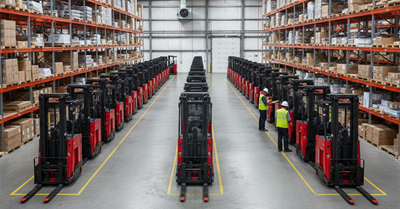Beyond Telematics: Using Data Analytics to Right-Size Your Material Handling Fleet

Go beyond telematics with advanced data analytics to right-size your material handling fleet, cut costs, boost utilization, and maximize warehouse efficiency.
Traditional fleet management strategies often leave warehouse managers playing a costly guessing game. While telematics provides valuable operational data, the real breakthrough comes when you leverage comprehensive analytics to transform raw information into strategic decisions that dramatically reduce equipment costs and maximize operational efficiency. This shift from reactive to predictive fleet management represents the next evolution in warehouse optimization.
The Hidden Costs of Fleet Mismanagement
Most warehouse operations suffer from fleet sizing decisions based on peak capacity requirements rather than actual utilization patterns. Industry studies reveal that companies implementing strategic fleet optimization see average cost reductions of 35% and productivity increases of up to 250%. Yet many facilities continue operating with oversized fleets that drain resources through excessive ownership costs, increased maintenance expenses, and operational complexities.
The problem extends beyond simple over-sizing. Without proper analytics, managers lack visibility into equipment utilization patterns, operator productivity metrics, and the true cost per pallet moved. This blind spot leads to decisions that seem logical but actually undermine operational efficiency and profitability.
Moving Beyond Basic Telematics
While telematics systems collect valuable data on vehicle location, operator behavior, and basic utilization metrics, they often fall short of providing the analytical depth needed for strategic fleet decisions. Advanced analytics platforms like Raymond's iWarehouse system go significantly further by integrating multiple data streams to create a comprehensive picture of fleet performance.
iWarehouse Evolution represents this analytical advancement, offering scalable solutions that grow with business needs while providing actionable insights for fleet optimization. The system combines traditional telematics data with advanced metrics like load sensing, task selection, and labor management integration to deliver enterprise-level visibility into operations.
Core Analytics Capabilities for Fleet Optimization
Equipment Utilization Analysis
Modern analytics platforms track not just operating hours, but true productivity metrics including loaded versus empty travel time, task completion rates, and route efficiency. This granular data reveals which equipment pieces justify their place in the fleet and which represent underutilized assets.
Predictive Maintenance Scheduling
Advanced systems analyze fault code patterns, operating conditions, and historical maintenance data to predict equipment issues before they occur. This proactive approach can reduce unplanned maintenance costs by 20-30% while extending equipment lifespan.
Cost Per Task Analytics
Rather than measuring simple cost per operating hour, sophisticated analytics break down expenses by specific tasks like pallet moves, picks, or load cycles. This approach provides clearer ROI metrics and helps identify optimization opportunities that might otherwise remain hidden.
Operator Performance Integration
Comprehensive fleet analytics incorporate operator training records, certification status, and productivity metrics to optimize both human and equipment resources simultaneously. This holistic approach ensures that fleet sizing decisions account for the critical human element in material handling operations.
The Right-Sizing Decision Framework
Effective fleet optimization requires a systematic approach that goes beyond simple utilization thresholds. Analytics platforms enable managers to establish data-driven criteria for fleet sizing decisions based on multiple performance indicators.
Utilization Pattern Analysis
Advanced analytics reveal not just average utilization rates, but usage patterns throughout different shifts, seasons, and operational cycles. This temporal analysis helps identify opportunities to redeploy equipment or adjust fleet composition without compromising operational capability.
Multi-Facility Optimization
For operations spanning multiple locations, analytics platforms provide enterprise-wide visibility that enables strategic equipment allocation across facilities. This capability allows managers to balance fleet resources dynamically based on changing operational demands.
Total Cost of Ownership Modeling
Sophisticated analytics incorporate not just acquisition and maintenance costs, but also opportunity costs of downtime, efficiency losses from suboptimal equipment selection, and the hidden expenses of oversized fleets. This comprehensive cost modeling supports more accurate fleet sizing decisions.
Implementation Strategy for Analytics-Driven Fleet Management
Start with Baseline Assessment
Implementing advanced analytics begins with establishing current fleet performance baselines. This involves comprehensive data collection on equipment utilization, maintenance costs, operator productivity, and task completion metrics. The assessment reveals optimization opportunities and provides benchmarks for measuring improvement.
Phased Technology Deployment
Rather than attempting full-scale implementation immediately, successful analytics deployment follows a phased approach. Begin with core telematics functionality, then gradually add advanced features like load sensing, task tracking, and predictive maintenance capabilities. This staged implementation allows operations to adapt while building analytics capabilities.
Cross-Functional Integration
Effective fleet analytics require integration across multiple operational systems including warehouse management, maintenance scheduling, and labor management platforms. This integration ensures that fleet optimization decisions consider all relevant operational factors.
Measuring Success and ROI
Key Performance Indicators
Successful analytics implementation focuses on specific, measurable outcomes rather than general efficiency improvements. Critical metrics include equipment utilization rates, cost per pallet moved, maintenance cost reduction, and operator productivity improvements.
Financial Impact Assessment
Companies utilizing advanced fleet analytics can often achieve a 20% improvement in equipment utilization, and up to 30% reduction in maintenance costs. These improvements translate directly to bottom-line results while supporting operational scalability.
Continuous Optimization Process
Analytics-driven fleet management is not a one-time implementation but an ongoing optimization process. Regular data analysis reveals new opportunities for improvement and helps adapt fleet composition to changing operational requirements.
Learn More About Warehouse Optimization
The transition from basic telematics to comprehensive analytics represents a fundamental shift in fleet management philosophy. Rather than reacting to equipment failures or capacity constraints, advanced analytics enable proactive optimization that reduces costs while improving operational performance. For warehouse managers seeking to maximize their material handling investment, the question is not whether to implement advanced analytics, but how quickly they can begin leveraging these capabilities to transform their operations.
Ready to discover how iWarehouse analytics can revolutionize your fleet management strategy? Contact Raymond West today to explore how data-driven optimization can reduce your equipment costs while maximizing warehouse efficiency. Your fleet – and your bottom line – will thank you.

